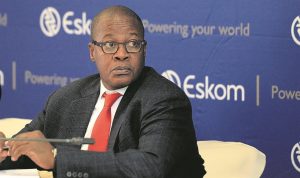Turnaround to sustain Eskom
The sustainability of Eskom, it noted, depends on the successful implementation of its turnaround strategy; which would require a stabilisation phase that will focus on revenue protection and a re-energisation phase.
Six strategic shifts were identified:
- Exploring new revenue sources
- Upstream initiatives
- Downstream initiatives
- Partnerships to enable growth
- Technology to exploit opportunities
- Adapting to different pathways to achieve a cost-reflective price.
Acting chairman Dr Ben Ngubane cautioned, in the integrated report; that delaying critical maintenance and refurbishment caused an escalation of breakdowns. A short-term recovery strategy was developed to reduce unplanned maintenance and achieve higher levels of plant availability.
Delays in delivering on the new build programme placed additional pressures on generating plants, leaving little residual capacity for maintenance. Acting CEO Brian Molefe noted that 2015 was unusually challenging: cash reserves declined, municipal debt increased, credit ratings were down and new build projects were behind schedule.
Interventions by the Inter-Ministerial “War Room” were required: a predictable price path, an equity injection of R23bn, declaration of coal as a strategic resource, introduction of demand management options and solutions to recover rising municipal debt. Load-shedding became more regular, disrupting households, industry and economic activity but it was an important step to prevent total blackouts.
Eskom established an independent inquiry into the state of its business. Four senior executives were asked to step aside during the enquiry. Chairperson Zola Tsotsi stepped down and Ben Ngubane replaced him. Brian Molefe became CEO. The national electrification programme focused on rural and remote areas where construction is more expensive. R29m went to the electrification of 44 schools. Mobile applications were launched to enable customers to access instant information on Eskom and advice on how to utilise energy efficiently.
Financial performance deteriorated: electricity sales declined while primary energy cost increased by 19%, which was above inflation and the Nersa tariff increase of 8%. Net profit decreased from R7.1bn to R3.6bn. The transmission division achieved an excellent technical performance but the ability to sustain this within the financial constraints remained a risk. Some power stations were reaching the limits of their ashing areas and these facilities had to be extended. Water requirements for the next two years were secured. Eskom negotiated with Mozambique on the possible construction of a gas pipeline and gas-fired power stations.
A climate change strategy was put in place and Eskom noted the success in lowering emissions of ash. On the positive side: coal tonnage delivered by rail exceeded the target, the first synchronisation of Medupi Unit 6 was achieved, the wind farm near Vredendal entered commercial operation, progress was made on the Majuba rail project, the Vaal River bridge was nearing completion and Eskom committed to facilitate the participation of independent power producers.

It was recognised for its commitment to environmental sustainability – for the second year. The Eskom Development Foundation was recognised by the American Chamber of Commerce for its programme to support emerging farmers and develop the skills of farm workers. It invested more than R115m in several educational projects – completing five FET colleges, building school classrooms, producing graduates from its Contractor Academy and reaching more than 44 000 learners and teachers through its maths and science programmes.
